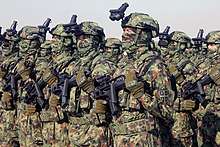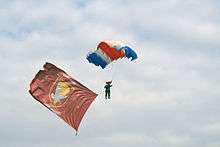63rd Parachute Brigade
The 63rd Parachute Brigade (Serbian: 63. Падобранска бригада/63. Padobranskа brigada) is one of the special forces brigade of the Serbian Army. Before it was a part of Yugoslav People's Army until 1992 and Yugoslav Federal Army (1992-2006). Since 2006 it used to be battalion until 21.12.2019., but in 2019 has the status of a brigade within newly restructured Serbian Army in order to readdress new defense tasks within army due to increased defense threats and in order to better honor traditions of pasts.[1][2][3] It is intended for special, reconnaissance and diversionary operations deep behind enemy lines.
| 63rd Parachute Brigade | |
|---|---|
| 63. Падобранска бригада | |
 | |
| Active | 1953–1959 1967–2006 2019–present |
| Country | |
| Branch | Serbian General Staff |
| Type | Paratroop |
| Garrison/HQ | Niš |
| Motto(s) | "For fatherland, for comrade, for rifle, for soldiers and warriors honor, parachutists of 63. paratroopers battalion, WORK!" Serbian: "Za otadžbinu, za druga, za pušku, za vojničku i ratničku čast, padobranci 63. padobranskog bataljona, RADE!" |
| Commanders | |
| Current commander | Lt. col. Nenad Bulatović |
| Insignia | |
| Patch |  |
Competences
When the competences of the 63rd Paratroop Brigade members are analyzed, the point to underscore is the safety coefficient of parachutist training, a parameter which, in spite of several tens of thousands of dives made in the last 15 years, is by far better than the comparable safety indicates for parachute units of the world's most powerful armies. This speaks for the high training standards and competence of the parachutists and a high degree of safety in training. In turn this suggests that strong work discipline, excellent abilities of officers and parachute instructors, highest-quality psycho-physical and expert coaching of the men, thorough checkups and perfect condition of parachute accessories, together with high morale of individual and units, reduce risk.
History
The first parachute jump in Yugoslavia was taken at the Novi Sad Airport on 2 September 1926. Second Lieutenant Dragutin Dolanski was dropped from an altitude of 650 meters (2100 feet). The year 1938 was particularly significant for the Yugoslav parachuting, since that was when the First International Aircraft Exhibition was staged in Belgrade. The Exhibition at the Zemun Airport included a combined jump of 10 parachutists, including Katarina Matanović, the first and only woman parachutist in Yugoslavia prior to the 1941 war. The Yugoslav Army had realized the significance of parachute units, and a school of parachuting was opened at Pančevo on 1 October 1939. The School was moved to Novi Sad in 1941, where it remained stationed until the outbreak of the war, whence a move to Niš was scheduled. The fate of the School of Parachuting in the April War has not yet been ascertained. In the Second World War, paratroop raids had a significant role in almost all major military operations. In mid-1944, the Supreme Headquarters requested help from the Allies to form a parachute unit. After the transfer of the Supreme Headquarters to the Island of Vis, urgent orders to lower-level commands were delivered by parachuted messengers.
In September 1944, a hundred troops were taken to Bari, Italy,[4] for a parachuting training course. Another hundred volunteers were selected for training from among the wounded soldiers recovering in Italy. The training and drops from airplanes took place in a training centre at Gravina. The School of Parachuting was successfully completed by 191 troops and officers. After completion of the training course on 14 October 1944, the First Parachute Battalion was formed, with Lieutenant Čedomir Vranić appointed its commander. The 1st Parachute Battalion recruits also underwent diversionary training, topography and target-shooting courses, and had intensive live-ammunition shooting practice. The Allies supplied the Battalion with complete weaponry and materiel (except for parachutes). In December 1944, the Battalion was shipped to Dubrovnik. On 6 January 1945, the Battalion arrived in Belgrade. This elite Battalion had had no combat experience during the Second World War. In mid-July 1945, the 1st Parachute Battalion was disbanded.
Apart from Italy, a number of Yugoslav paratroops were trained in the USSR during the Second World War. Upon return to the country, they were integrated into the existing parachute units. In the 1946-1950 period, a parachute training course was operative under the Air Force Command. In 1946, on the order of the Supreme Headquarters, the 46th Parachute Battalion was formed at Bela Crkva. In 1948, the Battalion was relocated to Novi Sad. Because of the threat of potential invasion from the east, the Battalion was again relocated, this time to Mostar, in January 1951. In 1952, the 46th Parachute Battalion was divided into two parts. One part remained at Mostar, and the other was transferred to Šabac. Out of this part the new 63rd Parachute Battalion was formed. The Battalion remained stationed at Mostar until 1954, when it was transferred back to Novi Sad and combined with the newly formed 63rd Parachute Brigade.
By Order No. 200 of the Armed Forces Supreme Command (VKOS) of 5 February 1953, the 63rd Parachute Brigade was formed at Šabac. The Brigade was relocated to Novi Sad in March 1954 thanks to more agreeable circumstances. Considerable errors have been committed in the understanding of this unit's use and combat tasks. The prevailing position was that the Yugoslav People's Army(JNA) did not need larger parachute units, as, presumably, battlefield drops from the air had no chance of success in a nuclear war and with modern anti-aircraft defence and mass armoured vehicles in use. On the order of the JNA General Headquarters, the 63rd Parachute Brigade was dismissed in late 1959, and out of it 3 independent parachute battalions were formed: 159th Parachute Battalion in Skopje; 127th Parachute Battalion at Batajnica; and 148th Parachute Battalion at Cerklje. In 1964, a Parachute Training Centre was formed by combining the 159th and 127th Parachute Battalions in Niš. The 63rd Parachute Brigade was once more formed on 5 December 1967 by combining the Parachute Training Centre and the 148th Parachute Battalion. From 1967 on, the 63rd Parachute Brigade has been stationed in Niš. The Parachute Brigade recruits have participated in numerous parachuting and other domestic and international sports events, where they achieved enviable results.[5] The Parachute Brigade recruits have participated in numerous parachuting and other domestic and international sports events, where they achieved enviable results.
As 63rd Parachute Battalion
Since 2006 63rd Parachute Battalion was formed instead 63rd Parachute Brigade inside Special brigade of Serbian army. As battalion formation lasted until 21.12.2019. when a brigade that includes all members of former battalion was formed once again in honor of brigade brave history and new defense challenges.[6]
Training

In addition to being a highest-rank combat unit of this type in the Military of Serbia, the 63rd Paratroop Battalion is a unique "military school of parachuting". The "paras" are training experts on land also; they have an excellent knowledge of the mountain and its whims, of the plains, rivers and lakes, inhabited areas, communications and facilities of particular importance, in short, all the situations they may find themselves in both in peace and war. Sorties behind enemy front lines - reconnoitering and diversions - are their trademark.
Recent services
In all the crises of the postwar era, the 63rd Paratroop Battalion has always been the first deployed, with the highest degree of combat readiness. During the 1999 NATO war on Yugoslavia, the members of the 63rd Battalion fought against the KLA in Kosovo, but also with diversionary detachments attempting raids from Albania on the territory of Yugoslavia. Members of the 63rd Battalion particularly excelled in their duty during an operation near the Yugoslav-Albanian border.
Overview
From the forming of the Brigade until today, the paras have participated in 250 major combined tactical maneuvers. In the 1947-1990 period, 330,000 parachute dives had been taken, and from 1990 until now over 10,000 drops have been made each year. The 63rd Parachute Battalion earned the repute of one of the best units thanks to the exceptional efforts on the part of the troops and officers and high marks obtained in combined maneuvers.
The unit says its basic values are love of the fatherland and freedom, soldier's and parachutist's oaths, preservation of the honour of the arms, individual and collective courage. The 63rd has been awarded many recognitions which its members and command cadre are proud of: the Order of the National Hero[7] adorning our wartime banner, six Orders of Courage, and over a hundred other orders and medals awarded the 63rd Brigade members for participation in combat and other missions. Forty-six of its troops have given their lives while on parachuting and other missions.
See also
| Wikimedia Commons has media related to 63rd Parachute Brigade. |
References
- https://www.danas.rs/drustvo/pocelo-formiranje-63-padobranske-brigade-i-72-brigade-za-specijalne-operacije/
- http://www.politika.rs/scc/clanak/444464/Ponovo-postoje-63-padobranska-i-72-specijalna-brigada
- https://www.novosti.rs/vesti/naslovna/drustvo/aktuelno.290.html:837361-Ministar-Vulin-Ispunjeno-naredjenje-vrhovnog-komandanta-63-padobranska-i-72-za-specijalne-operacije-ponovo-brigade
- http://www.znanje.org/i/i22/02iv02/02iv0227/63%20padobranska%20tekst.htm
- "Niške "vidre" elita Vojske".
- http://www.politika.rs/sr/clanak/444464/Ponovo-postoje-63-padobranska-i-72-specijalna-brigada
- "Archived copy". Archived from the original on 6 April 2009. Retrieved 13 June 2009.CS1 maint: archived copy as title (link)
Bibliography
Books
- Jugoslovensko padobranstvo (1926–1990) ISBN 86-367-0773-0
- Babac, Dušan Specijalne jedinice jugoslovenske vojske u Aprilskom ratu ISBN 978-86-85957-12-3